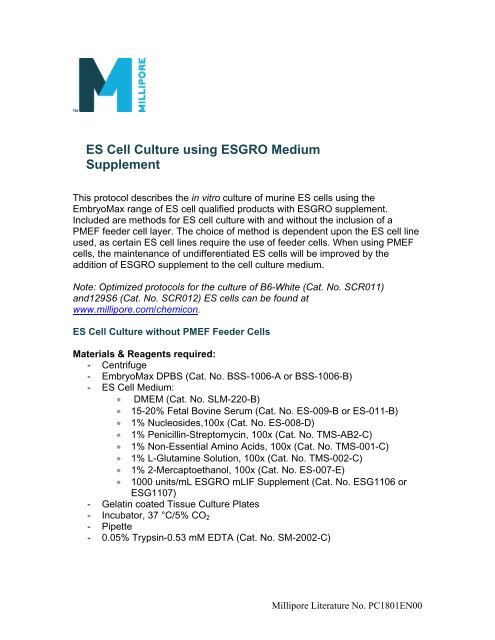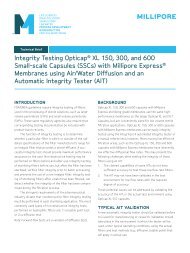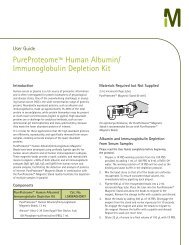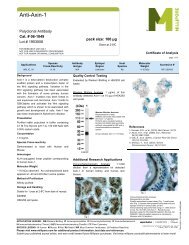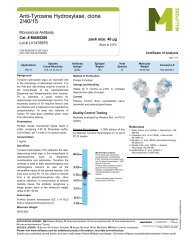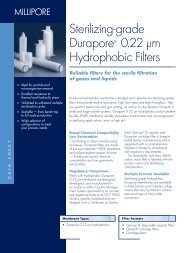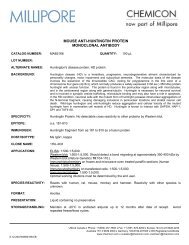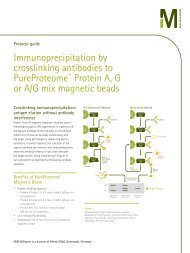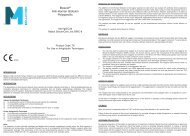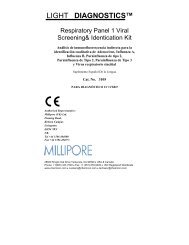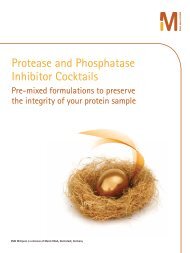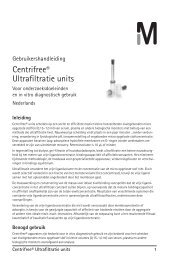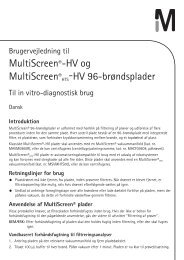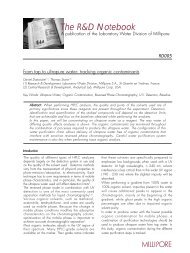ES Cell Culture using ESGRO Medium Supplement - Millipore
ES Cell Culture using ESGRO Medium Supplement - Millipore
ES Cell Culture using ESGRO Medium Supplement - Millipore
Create successful ePaper yourself
Turn your PDF publications into a flip-book with our unique Google optimized e-Paper software.
<strong>ES</strong> <strong>Cell</strong> <strong>Culture</strong> <strong>using</strong> <strong>ES</strong>GRO <strong>Medium</strong><br />
<strong>Supplement</strong><br />
This protocol describes the in vitro culture of murine <strong>ES</strong> cells <strong>using</strong> the<br />
EmbryoMax range of <strong>ES</strong> cell qualified products with <strong>ES</strong>GRO supplement.<br />
Included are methods for <strong>ES</strong> cell culture with and without the inclusion of a<br />
PMEF feeder cell layer. The choice of method is dependent upon the <strong>ES</strong> cell line<br />
used, as certain <strong>ES</strong> cell lines require the use of feeder cells. When <strong>using</strong> PMEF<br />
cells, the maintenance of undifferentiated <strong>ES</strong> cells will be improved by the<br />
addition of <strong>ES</strong>GRO supplement to the cell culture medium.<br />
Note: Optimized protocols for the culture of B6-White (Cat. No. SCR011)<br />
and129S6 (Cat. No. SCR012) <strong>ES</strong> cells can be found at<br />
www.millipore.com/chemicon.<br />
<strong>ES</strong> <strong>Cell</strong> <strong>Culture</strong> without PMEF Feeder <strong>Cell</strong>s<br />
Materials & Reagents required:<br />
- Centrifuge<br />
- EmbryoMax DPBS (Cat. No. BSS-1006-A or BSS-1006-B)<br />
- <strong>ES</strong> <strong>Cell</strong> <strong>Medium</strong>:<br />
• DMEM (Cat. No. SLM-220-B)<br />
• 15-20% Fetal Bovine Serum (Cat. No. <strong>ES</strong>-009-B or <strong>ES</strong>-011-B)<br />
• 1% Nucleosides,100x (Cat. No. <strong>ES</strong>-008-D)<br />
• 1% Penicillin-Streptomycin, 100x (Cat. No. TMS-AB2-C)<br />
• 1% Non-Essential Amino Acids, 100x (Cat. No. TMS-001-C)<br />
• 1% L-Glutamine Solution, 100x (Cat. No. TMS-002-C)<br />
• 1% 2-Mercaptoethanol, 100x (Cat. No. <strong>ES</strong>-007-E)<br />
• 1000 units/mL <strong>ES</strong>GRO mLIF <strong>Supplement</strong> (Cat. No. <strong>ES</strong>G1106 or<br />
<strong>ES</strong>G1107)<br />
- Gelatin coated Tissue <strong>Culture</strong> Plates<br />
- Incubator, 37 °C/5% CO2<br />
- Pipette<br />
- 0.05% Trypsin-0.53 mM EDTA (Cat. No. SM-2002-C)<br />
<strong>Millipore</strong> Literature No. PC1801EN00
<strong>ES</strong> <strong>Cell</strong> <strong>Culture</strong> <strong>using</strong> <strong>ES</strong>GRO <strong>Medium</strong> <strong>Supplement</strong><br />
Procedure:<br />
1. Thaw a vial containing 1x10 7 <strong>ES</strong> cells into 4 mL of <strong>ES</strong> <strong>Cell</strong> <strong>Medium</strong><br />
(containing <strong>ES</strong>GRO supplement at 1000 units/mL) and 4 mL of FBS.<br />
Centrifuge (3–5 minutes) and resuspend the cells in 10 mL of <strong>ES</strong> <strong>Cell</strong><br />
<strong>Medium</strong>. Plate the <strong>ES</strong> cells onto the gelatinized plates at a density of 1–<br />
1.5 x 10 6 cells/25 cm 2 (~3 x 10 6 cells/100 mm plate). Incubate the plates at<br />
37 °C with 5% CO2. The cells appearance should resemble Image 5A<br />
(following page).<br />
2. Examine the cells daily to determine if a change of media is required<br />
(indicated by a change of media color to yellow). After 2–3 days, <strong>ES</strong> cell<br />
cultures will become crowded with large colonies (see Image 5B). At this<br />
point, passage <strong>ES</strong> cells at a 1:2 ratio.<br />
3. To passage <strong>ES</strong> cells, prepare two 100 mm gelatinized plates in advance.<br />
Remove <strong>ES</strong> <strong>Cell</strong> <strong>Medium</strong>, wash plates twice with DPBS, and add 1.2 mL<br />
of Trypsin. Incubate plates at 37 °C for 2 minutes, and then add 10 mL of<br />
<strong>ES</strong> cell medium. Pipette vigorously to break up the <strong>ES</strong> cell aggregates<br />
(avoid bubble formation).<br />
4. Add 5 mL of the cell suspension to each gelatinized plate containing 5 mL<br />
of <strong>ES</strong> <strong>Cell</strong> <strong>Medium</strong>. Excess <strong>ES</strong> cells can be frozen at a concentration of<br />
2–10 x 10 6 cells per vial for future use. Please note that <strong>ES</strong> cells should<br />
always be passaged the day before you intend to electroporate.<br />
2
<strong>ES</strong> <strong>Cell</strong> <strong>Culture</strong> <strong>using</strong> <strong>ES</strong>GRO <strong>Medium</strong> <strong>Supplement</strong><br />
<strong>ES</strong> <strong>Cell</strong> <strong>Culture</strong> with PMEF Feeder <strong>Cell</strong>s<br />
Materials & Reagents required:<br />
- Centrifuge<br />
- EmbryoMax DPBS (Cat. No. BSS-1006-A or BSS-1006-B)<br />
- <strong>ES</strong> <strong>Cell</strong> <strong>Medium</strong>:<br />
• DMEM (Cat. No. SLM-220-B)<br />
• 15-20% Fetal Bovine Serum (Cat. No. <strong>ES</strong>-009-B or <strong>ES</strong>-011-B)<br />
• 1% Nucleosides,100x (Cat. No. <strong>ES</strong>-008-D)<br />
• 1% Penicillin-Streptomycin, 100x (Cat. No. TMS-AB2-C)<br />
• 1% Non-Essential Amino Acids, 100x (Cat. No. TMS-001-C)<br />
• 1% L-Glutamine Solution, 100x (Cat. No. TMS-002-C)<br />
• 1% 2-Mercaptoethanol, 100x (Cat. No. <strong>ES</strong>-007-E)<br />
• 1000 units/mL <strong>ES</strong>GRO mLIF <strong>Supplement</strong> (Cat. No. <strong>ES</strong>G1106 or<br />
<strong>ES</strong>G1107)<br />
- Incubator, 37 °C/5% CO2<br />
- Pipette<br />
- PMEF Feeder cell coated plates<br />
- 0.05% Trypsin-0.53mM EDTA (Cat. No. SM-2002-C)<br />
Procedure:<br />
1. Thaw a vial containing 1x10 7 <strong>ES</strong> cells into 4 mL of <strong>ES</strong> <strong>Cell</strong> <strong>Medium</strong><br />
(containing <strong>ES</strong>GRO supplement at 1000 units/mL) and 4 mL of FBS.<br />
Centrifuge (3–5 minutes) and resuspend the cells in 10 mL of <strong>ES</strong> <strong>Cell</strong><br />
<strong>Medium</strong>.<br />
2. Remove the PMEF Feeder <strong>Cell</strong> <strong>Medium</strong> from a feeder plate prepared<br />
earlier (see Section 4), and seed the <strong>ES</strong> cells onto the PMEF coated plate<br />
at a density of 1–1.5 x 10 6 cells/25 cm2 (~3 x 10 6 cells/100 mm plate).<br />
Incubate the plates at 37 °C with 5% CO2. The cells appearance should<br />
resemble Image 5C (below).<br />
3. Examine the cells daily to determine if a change of media is required<br />
(indicated by a change of media color to yellow). After 2–3 days, the <strong>ES</strong><br />
cell cultures will become crowded with large colonies (see Image 5D). At<br />
this point, passage the <strong>ES</strong> cells at a 1:2 ratio.<br />
4. To passage <strong>ES</strong> cells, prepare two 100 mm plates containing PMEF cells<br />
as previously described (see Section 4). Remove the <strong>ES</strong> <strong>Cell</strong> <strong>Medium</strong>,<br />
wash plates twice with DPBS, and add 1.2 mL of Trypsin. Incubate at<br />
37 °C for 2 minutes. Add 10 mL of <strong>ES</strong> <strong>Cell</strong> <strong>Medium</strong> and pipette vigorously<br />
to disperse the <strong>ES</strong> cell aggregates (avoid bubble formation).<br />
5. Add 5 mL of the cell suspension to each of the PMEF cell plates<br />
containing 5 mL of <strong>ES</strong> <strong>Cell</strong> <strong>Medium</strong>. Excess <strong>ES</strong> cells can be frozen at a<br />
concentration of 2–10 x 10 6 cells per vial for future use. Please note that<br />
<strong>ES</strong> cells should always be passaged the day before you intend to<br />
electroporate.<br />
3
<strong>ES</strong> <strong>Cell</strong> <strong>Culture</strong> <strong>using</strong> <strong>ES</strong>GRO <strong>Medium</strong> <strong>Supplement</strong><br />
4


